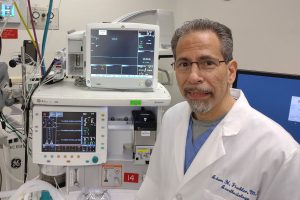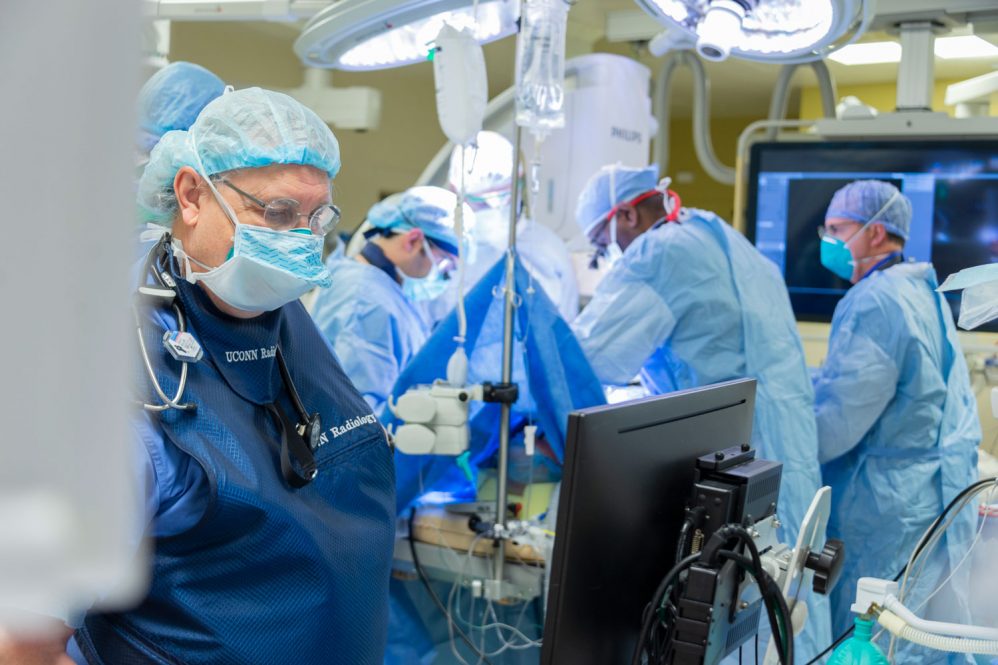As Earth Day 2022 nears, and the pandemic, with its draw on institutional resources, subsides, UConn Health is taking stock of its sustainability efforts. Some are new, some are on hold from before COVID-19.
And one in particular has been happening over the last year anyway.
What that’s doing is reducing our greenhouse gas emissions by 40% to 50%. — Dr. Adam Fischler

Under an initiative spearheaded by Dr. Adam Fischler, an anesthesiologist with several roles and titles at UConn Health, including “section chief, sustainability,” the anesthesia providers are using less anesthesia gas while providing the same care to surgical patients.
“When anesthetic gases are released into the scavenging system, these global warming gases are released from our rooftop directly into the atmosphere,” Fischler says. “We can reduce this by reducing the flow of air and oxygen when delivering anesthesia to patients.”
Historically, in a typical general anesthesia case, the air and oxygen flow rate to deliver the anesthetic gas would be at least 2 liters per minute. But that’s more than double what the body actually needs. excess flow is removed from the system, carrying with it the molecules of anesthetic gas, and gets released to the environment. Since the body metabolizes less than 5% of the gas, nearly the entire amount of gas is eventually scavenged and released. With a lower flow rate, less anesthesia gas is picked up, so less ends up in the atmosphere. The patient still gets the same concentration of anesthesia gas while increasing efficiency, reducing waste, and saving money.
“What we’re doing now is, we’re using between 1 and 1.2 liters per minute,” Fischler says. “What that’s doing is reducing our greenhouse gas emissions by 40% to 50%.”
Additionally, with the help of UConn Health’s software programmers, Fischler has implemented a pop-up reminder in Epic, the electronic health record system, which alerts providers to keep gas flows at or below 1.2 liters per minute during general anesthesia.
Another consideration is the type of anesthetic gas used. When comparing the top three — desflurane, sevoflurane, and nitrous oxide — there’s a clear-cut winner when it comes to environmental considerations, measured by greenhouse gas potency or “lifetime” in the atmosphere.
“Sevoflurane, while still a greenhouse gas, causes the least global warming,” Fischler says. “Nitrous oxide is three times worse as a global warming gas, lasting more than 100 years in our atmosphere, and depleting the ozone layer. Desflurane is 28 times worse than Sevoflurane. There may be a slight trade-off but not enough to make up for the harm to the environment.”
These practices have become more mainstream in anesthesiology over the last two years, embraced by the American Society of Anesthesiologists.
While anesthesiology is one of the biggest components of the OR’s carbon footprint, other sustainability targets include a shift toward more reusable supplies to reduce waste, and continuing to improve the practice of differentiating waste for proper disposal or recycling.
One tactic already in use at UConn Health’s pharmacy is the dispensing of certain medications directly into the syringe rather than in a vial that later needs to be transferred into a syringe, with the unused portion wasted.
“Discussion and awareness can foster the thought process, and that’s gone a long way,” Fischler says. “People kept coming up with ideas for reducing waste and providing more sustainable health care practices. This necessary endeavor is not a one-person job. It requires a coordinated response from many clinical and administrative individuals to make a difference.”

Beyond the OR, here’s a rundown on sustainability efforts at UConn Health, according to Eric Kruger, vice president of facilities development and operations:
Complete
- Steam trap repairs to improve efficiency of heat and hot water systems
- Seven buildings with either LEED Gold or LEED Silver certification, resulting in minimal carbon footprints
- Retrofit lighting to LED fixtures at the fire house and the Administrative Services Building (second and third floors)
Underway
- Combined with Storrs, UConn Health purchases a firm supply of 100% green electrical power, which gives the University credits to offset its carbon footprint
- Request for proposal to install fuel cell technology
Upcoming
- Retrofit lighting to LED fixtures – street lights and parking lots
- Update fume hoods in research labs with occupancy sensors and programmable air changes
“We’re also planning to reconvene UConn Heath’s sustainability work group later this year,” Kruger says.



